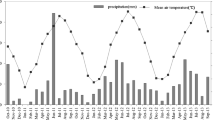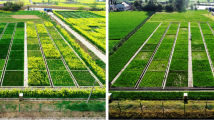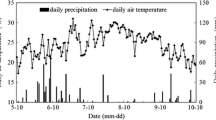Abstract
Straw return and optimized nitrogen fertilizer application are common agronomic measures used in agricultural production, but the greenhouse effect these measures induce is often ignored. In this study, four treatments were employed: conventional fertilization (CF), optimized nitrogen fertilization (OF), conventional fertilization + straw return (CF + S), and optimized nitrogen fertilization + straw return (OF + S). A “closed static box” method was used to monitor methane (CH4) and nitrous oxide (N2O) emissions, and the variations in the ground temperature at 5-cm depth, soil nitrogen content, and soil organic matter content were analyzed. The results showed that OF reduced the soil nitrogen content, which reduced soil N2O emissions. Straw return increased the ground temperature at 5-cm depth and increased the soil organic matter content, which increased CH4 emissions. Compared with CF, the cumulative emissions of CH4 from the paddy soils of OF and OF + S decreased by 10.75% and 18.48%, respectively, while that of CF + S increased by 13.83%. The cumulative N2O emissions from the paddy soils of OF, CF + S, and OF + S decreased by 18.36%, 24.64%, and 32.85%, respectively. The global warming potential (GWP) of OF and OF + S decreased significantly, but the GWP of CF + S increased, and all treatments improved rice and wheat yields. The trend in the greenhouse gas emission intensity (GHGI) was the same as that of GWP. In general, the application of straw provided additional nutrients to the soil, compensated for the reduction in soil nutrients caused by nitrogen reduction and fertilizer reduction, and ensured high rice yields.



Similar content being viewed by others
References
Ahmad, S., et al. (2019). Climate warming and management impact on the change of phenology of the rice-wheat cropping system in Punjab. Pakistan Field Crops Research, 230, 46–61. https://doi.org/10.1016/j.fcr.2018.10.008
Bao, Q., Huang, Y., Wang, F., Nie, S., Nicol, G. W., Yao, H., & Ding, L. (2016). Effect of nitrogen fertilizer and/or rice straw amendment on methanogenic archaeal communities and methane production from a rice paddy soil. Applied Microbiology and Biotechnology, 100, 5989–5998. https://doi.org/10.1007/s00253-016-7377-z
Berhane, M., Xu, M., Liang, Z., Shi, J., Wei, G., & Tian, X. (2020). Effects of long-term straw return on soil organic carbon storage and sequestration rate in North China upland crops: A meta-analysis. Global Change Biology. https://doi.org/10.1111/gcb.15018
Chen, H., Li, X., Hu, F., & Shi, W. (2013). Soil nitrous oxide emissions following crop residue addition: A meta-analysis. Global Change Biology, 19, 2956–2964. https://doi.org/10.1111/gcb.12274
Chen, X. P., Zhang, F. S., Cui, Z. L., Li, F., & Li, J. L. (2010). Optimizing soil nitrogen supply in the root zone to improve maize management. Soil Science Society of America Journal, 74, 1367–1373. https://doi.org/10.2136/sssaj2009.0227
Cui, Z., Wang, G., Yue, S., Wu, L., Zhang, W., Zhang, F., & Chen, X. (2014). Closing the N-use efficiency gap to achieve food and environmental security. Environmental Science and Technology, 48, 5780–5787. https://doi.org/10.1021/es5007127
Deng, O., et al. (2020). Emission of CO2 and CH4 from a multi-ditches system in rice cultivation region: Flux, temporal-spatial variation and effect factors. Journal of Environmental Management, 270, 118. https://doi.org/10.1016/j.jenvman.2020.110918
Fan, Y., Hao, X., Carswell, A., Misselbrook, T., Ding, R., Li, S., & Kang, S. (2021). Inorganic nitrogen fertilizer and high N application rate promote N2O emission and suppress CH4 uptake in a rotational vegetable system. Soil and Tillage Research. https://doi.org/10.1016/j.still.2020.104848
Fatima, Z., et al. (2020). The fingerprints of climate warming on cereal crops phenology and adaptation options. Scientific Reports, 10, 18013. https://doi.org/10.1038/s41598-020-74740-3
Han, M., Zhang, B., Zhang, Y., & Guan, C. (2019). Agricultural CH4 and N2O emissions of major economies: Consumption-vs. production-based perspectives. Journal of Cleaner Production, 210, 276–286. https://doi.org/10.1016/j.jclepro.2018.11.018
Haque, M. M., & Biswas, J. C. (2021). Emission factors and global warming potential as influenced by fertilizer management for the cultivation of rice under varied growing seasons. Environmental Research, 197, 111156. https://doi.org/10.1016/j.envres.2021.111156
Hou, P., et al. (2013). Methane emissions from rice fields under continuous straw return in the middle-lower reaches of the Yangtze River. Journal of Environmental Sciences, 25, 1874–1881. https://doi.org/10.1016/s1001-0742(12)60273-3
Htun, Y. M., Tong, Y., Gao, P., & Xiaotang, J. (2017). Coupled effects of straw and nitrogen management on N2O and CH4 emissions of rainfed agriculture in Northwest China. Atmospheric Environment, 157, 156–166. https://doi.org/10.1016/j.atmosenv.2017.03.014
Huang, Y., et al. (2021). Tradeoff of CO2 and CH4 emissions from global peatlands under water-table drawdown. Nature Climate Change, 11, 618–622. https://doi.org/10.1038/s41558-021-01059-w
Hussain, M., Ahmad, S., Hussain, S., Lal, R., Ul-Allah, S., & Nawaz, A. (2018). Chapter Six-rice in saline soils: Physiology, biochemistry, genetics, and management. In D. L. Sparks (Ed.), Advances in agronomy (pp. 231–287). Academic Press. https://doi.org/10.1016/bs.agron.2017.11.002
IPCC. (2013). Climate change 2013-the physical science basis: Working group I contribution to the fourth 495 assessment report of the IPCC. Cambridge University Press.
Kim, G. W., Lim, J. Y., Islam Bhuiyan, M. S., Das, S., Khan, M. I., & Kim, P. J. (2022). Investigating the arable land that is the main contributor to global warming between paddy and upland vegetable crops under excessive nitrogen fertilization. Journal of Cleaner Production. https://doi.org/10.1016/j.jclepro.2022.131197
Kim, K., Daly, E. J., & Hernandez-Ramirez, G. (2021). Perennial grain cropping enhances the soil methane sink in temperate agroecosystems. Geoderma. https://doi.org/10.1016/j.geoderma.2021.114931
Li, S. H., Guo, L. J., Cao, C. G., & Li, C. F. (2021). Effects of straw returning levels on carbon footprint and net ecosystem economic benefits from rice-wheat rotation in central China. Environmental Science and Pollution Research International, 28, 5742–5754. https://doi.org/10.1007/s11356-020-10914-w
Liang, K., et al. (2017). Nitrogen losses and greenhouse gas emissions under different N and water management in a subtropical double-season rice cropping system. Science of the Total Environment, 609, 46–57. https://doi.org/10.1016/j.scitotenv.2017.07.118
Liu, X., Ren, J., Zhang, Q., & Liu, C. (2019). Long-term effects of biochar addition and straw return on N2O fluxes and the related functional gene abundances under wheat-maize rotation system in the North China Plain. Applied Soil Ecology, 135, 44–55. https://doi.org/10.1016/j.apsoil.2018.11.006
Lu, F. E. I., Wang, X., Han, B., Ouyang, Z., Duan, X., Zheng, H. U. A., & Miao, H. (2009). Soil carbon sequestrations by nitrogen fertilizer application, straw return and no-tillage in China’s cropland. Global Change Biology, 15, 281–305. https://doi.org/10.1111/j.1365-2486.2008.01743.x
Ma, J., Li, X. L., Xu, H., Han, Y., Cai, Z. C., & Yagi, K. (2007). Effects of nitrogen fertiliser and wheat straw application on CH4 and N2O emissions from a paddy rice field. Soil Research. https://doi.org/10.1071/sr07039
Martins, C. S. C., Macdonald, C. A., Anderson, I. C., & Singh, B. K. (2016). Feedback responses of soil greenhouse gas emissions to climate change are modulated by soil characteristics in dryland ecosystems. Soil Biology and Biochemistry, 100, 21–32. https://doi.org/10.1016/j.soilbio.2016.05.007
Mrowczynska-Kaminska, A., Bajan, B., Pawlowski, K. P., Genstwa, N., & Zmyslona, J. (2021). Greenhouse gas emissions intensity of food production systems and its determinants. PLoS ONE, 16, e0250995. https://doi.org/10.1371/journal.pone.0250995
Nie, J., et al. (2021). Effect of fertilization regimes and seasonal change on nosZ-denitrifying bacterial community in a double-rice paddy field. Journal of Soil Science and Plant Nutrition. https://doi.org/10.1007/s42729-021-00651-5
Qamar, R., Rehman, A., Javeed, H. M. R., Abdul Rehman, A. R., Safdar, M. E., Ali, H., & Ahmad, S. (2021). Tillage systems affecting rice-wheat cropping system. Sains Malaysiana, 50, 1543–1562. https://doi.org/10.17576/jsm-2021-5006-04
Rizzo, A., Boano, F., Revelli, R., & Ridolfi, L. (2015). Groundwater impact on methane emissions from flooded paddy fields. Advances in Water Resources, 83, 340–350. https://doi.org/10.1016/j.advwatres.2015.07.005
Romasanta, R. R., et al. (2017). How does burning of rice straw affect CH4 and N2O emissions? A comparative experiment of different on-field straw management practices. Agriculture, Ecosystems and Environment, 239, 143–153. https://doi.org/10.1016/j.agee.2016.12.042
Sarwar, N., et al. (2021). Integrated nitrogen management improves productivity and economic returns of wheat-maize cropping system. Journal of King Saud University Science. https://doi.org/10.1016/j.jksus.2021.101475
Song, H., Che, Z., Cao, W., Huang, T., Wang, J., & Dong, Z. (2016). Changing roles of ammonia-oxidizing bacteria and archaea in a continuously acidifying soil caused by over-fertilization with nitrogen. Environmental Science and Pollution Research International, 23, 11964–11974. https://doi.org/10.1007/s11356-016-6396-8
Van Groenigen, J. W., Velthof, G. L., Oenema, O., Van Groenigen, K. J., & Van Kessel, C. (2010). Towards an agronomic assessment of N2O emissions: a case study for arable crops. European Journal of Soil Science, 61, 903–913. https://doi.org/10.1111/j.1365-2389.2009.01217.x
Wang, C., Lai, D. Y., Sardans, J., Wang, W., Zeng, C., & Penuelas, J. (2017a). Factors Related with CH4 and N2O Emissions from a Paddy Field: Clues for Management implications. PLoS ONE, 12, e0169254. https://doi.org/10.1371/journal.pone.0169254
Wang, J., Zhang, X., Xiong, Z., Khalil, M. A. K., Zhao, X., Xie, Y., & Xing, G. (2012). Methane emissions from a rice agroecosystem in South China: Effects of water regime, straw incorporation and nitrogen fertilizer. Nutrient Cycling in Agroecosystems, 93, 103–112. https://doi.org/10.1007/s10705-012-9503-3
Wang, N., Yu, J.-G., Zhao, Y.-H., Chang, Z.-Z., Shi, X.-X., Ma, L. Q., & Li, H.-B. (2018). Straw enhanced CO2 and CH4 but decreased N2O emissions from flooded paddy soils: Changes in microbial community compositions. Atmospheric Environment, 174, 171–179. https://doi.org/10.1016/j.atmosenv.2017.11.054
Wang, W., Sardans, J., Wang, C., Zeng, C., Tong, C., Asensio, D., & Peñuelas, J. (2017b). Relationships between the potential production of the greenhouse gases CO2, CH4 and N2O and soil concentrations of C, N and P across 26 paddy fields in southeastern China. Atmospheric Environment, 164, 458–467. https://doi.org/10.1016/j.atmosenv.2017.06.023
Xia, L., Lam, S. K., Chen, D., Wang, J., Tang, Q., & Yan, X. (2017). Can knowledge-based N management produce more staple grain with lower greenhouse gas emission and reactive nitrogen pollution? A meta-analysis. Global Change Biology, 23, 1917–1925. https://doi.org/10.1111/gcb.13455
Xia, L., Wang, S., & Yan, X. (2014). Effects of long-term straw incorporation on the net global warming potential and the net economic benefit in a rice–wheat cropping system in China Agriculture. Ecosystems and Environment, 197, 118–127. https://doi.org/10.1016/j.agee.2014.08.001
Xu, P., et al. (2020). Conversion of winter flooded rice paddy planting to rice-wheat rotation decreased methane emissions during the rice-growing seasons. Soil and Tillage Research. https://doi.org/10.1016/j.still.2019.104490
Yang, S., Yn, X., Sun, X., Ding, J., Jiang, Z., & Xu, J. (2019). Biochar improved rice yield and mitigated CH4 and N2O emissions from paddy field under controlled irrigation in the Taihu Lake Region of China. Atmospheric Environment, 200, 69–77. https://doi.org/10.1016/j.atmosenv.2018.12.003
Zhang, G., et al. (2020a). Reducing yield-scaled global warming potential and water use by rice plastic film mulching in a winter flooded paddy field. European Journal of Agronomy. https://doi.org/10.1016/j.eja.2020.126007
Zhang, K., et al. (2022). Optimizing spikelet fertilizer input in irrigated rice system can reduce nitrous oxide emission while increase grain yield. Agriculture Ecosystems and Environment. https://doi.org/10.1016/j.agee.2021.107737
Zhang, Y., Hou, W., Chi, M., Sun, Y., An, J., Yu, N., & Zou, H. (2020b). Simulating the effects of soil temperature and soil moisture on CO2 and CH4 emissions in rice straw-enriched paddy soil. CATENA. https://doi.org/10.1016/j.catena.2020.104677
Zhou, M., Zhu, B., Wang, X., & Wang, Y. (2017a). Long-term field measurements of annual methane and nitrous oxide emissions from a Chinese subtropical wheat-rice rotation system. Soil Biology and Biochemistry, 115, 21–34. https://doi.org/10.1016/j.soilbio.2017.08.005
Zhou, Y., Zhang, Y., Tian, D., & Mu, Y. (2017b). The influence of straw returning on N2O emissions from a maize-wheat field in the North China Plain. Science of the Total Environment, 584–585, 935–941. https://doi.org/10.1016/j.scitotenv.2017.01.141
Acknowledgements
This research was supported by Anhui Province Science and Technology Major Special Project (2021d06050002) and Young Talent Project of Anhui Academy of Agricultural Sciences (QNYC-202109).
Author information
Authors and Affiliations
Corresponding author
Ethics declarations
Conflict of Interest
The authors declare that they have no known competing financial interests that could have appeared to influence the work reported in this paper.
Rights and permissions
Springer Nature or its licensor holds exclusive rights to this article under a publishing agreement with the author(s) or other rightsholder(s); author self-archiving of the accepted manuscript version of this article is solely governed by the terms of such publishing agreement and applicable law.
About this article
Cite this article
He, H., Li, D., Pan, F. et al. Effects of Nitrogen Reduction and Optimized Fertilization Combined with Straw Return on Greenhouse Gas Emissions and Crop Yields of a Rice–Wheat Rotation System. Int. J. Plant Prod. 16, 669–679 (2022). https://doi.org/10.1007/s42106-022-00212-5
Received:
Accepted:
Published:
Issue Date:
DOI: https://doi.org/10.1007/s42106-022-00212-5




